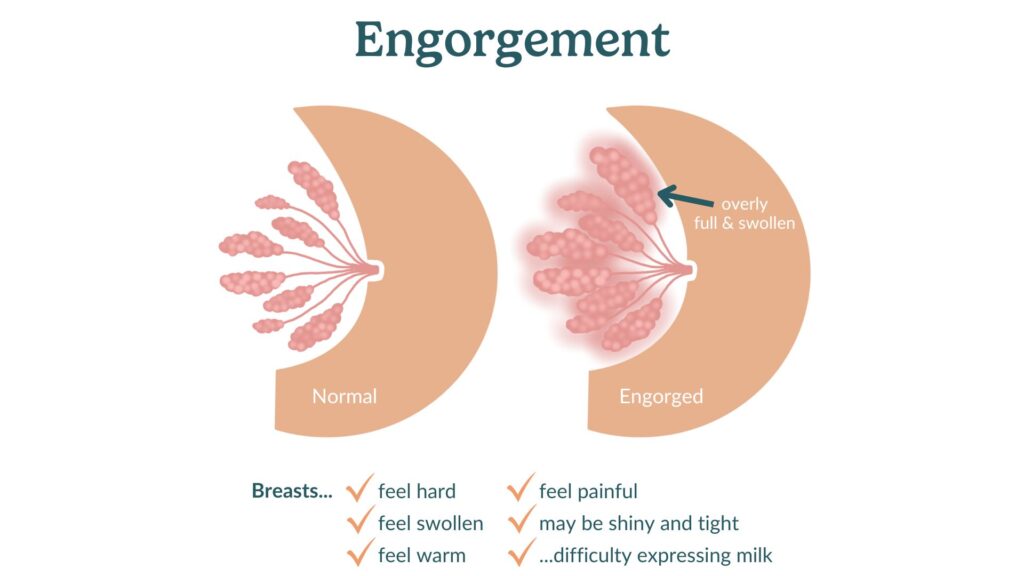engorgement

Engorgement
Engorgement is when your breasts become overly full, swollen, and painful due to an excess of milk. This usually happens in the early days of breastfeeding when your milk first comes in or when there is a sudden change in your breastfeeding routine. Engorgement can make it difficult for your baby to latch on properly and can be uncomfortable for you. Learn more about engorgement.
What to watch out for
Engorgement can cause several issues if not managed properly. Here’s what to look out for and how to address them.
Signs of engorgement
Your breasts may feel hard, swollen, warm, and painful. You might also notice that your breasts are shiny and tight, and you may have difficulty expressing milk. These signs usually appear a few days after birth when your milk supply increases.
Difficulty with latch
Engorgement can make it harder for your baby to latch because the breast tissue is too firm. To help your baby latch, try softening your nipple area by expressing a little milk before feeding. You can also use breast compression during feeding to help the milk flow. Check that your baby has a good latch.
Blocked milk ducts
If engorgement is not relieved, it can lead to blocked milk ducts. These feel like tender lumps in your breast and can cause localized pain. To prevent or relieve blocked ducts, continue breastfeeding or pumping frequently, massage the affected area, and apply warm compresses before feeding. Learn more about plugged ducts.
How to relieve engorgement
Engorgement typically lasts a few days to a week. Here are some tips to help relieve it:
- Frequent breastfeeding: Nurse your baby often, at least 8-12 times in 24 hours. Make sure they have a proper latch.
- Express milk: Hand express or pump a small amount of milk to soften the breast if your baby is having trouble latching.
- Cold compresses: Use a cold compress after or between feedings to reduce swelling and discomfort.
- Breast massage: Gently massage your breasts while feeding or pumping to help empty the milk ducts.
- Breast gymnastics: Gently lift your breasts up and down, then in circular motions to elongate the ductules and help your milk start flowing.
If engorgement persists beyond a week or is very painful, consult a lactation consultant or healthcare provider for further advice and support.
Physical limitations or health circumstances
Certain conditions or situations may make engorgement more likely or harder to manage.
Sudden changes in feeding routine
If you suddenly change your breastfeeding routine, such as skipping feeds or stopping breastfeeding abruptly, you may be more prone to engorgement. Gradually weaning your baby can help prevent this.
Oversupply of milk
Some mamas produce more milk than their baby needs, which can lead to frequent engorgement. In this case, working with a lactation consultant to manage your milk supply can help. Learn more about managing milk supply.
Other terms
Understanding related terms can help you manage and prevent engorgement more effectively.
- Blocked milk ducts: Occur when milk gets trapped in the ducts, leading to lumps and localized pain. Frequent breastfeeding and massage can help.
- Mastitis: An infection that can develop if engorgement or blocked ducts are not treated, causing breast pain, swelling, and flu-like symptoms. Read more about mastitis.
- Milk supply: The amount of milk your body produces. Effective breastfeeding practices help maintain a healthy supply.
- Let-down reflex: The release of milk from your breasts, triggered by your baby's sucking. Engorgement can affect the let-down reflex. Learn more about let-down reflex.
- Lactation consultant: A breastfeeding expert who can provide support and advice for managing engorgement and other breastfeeding challenges.


